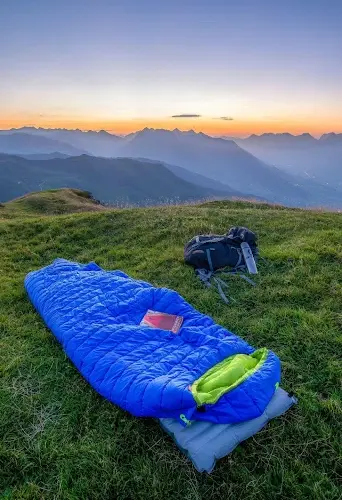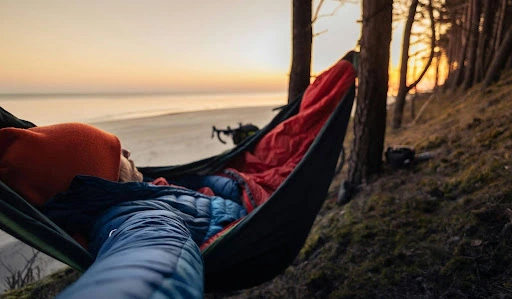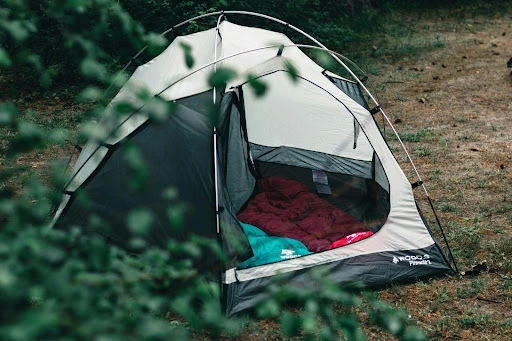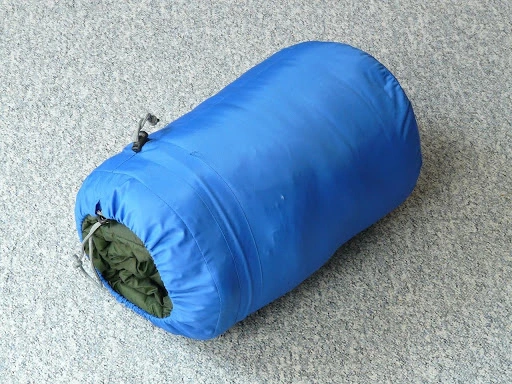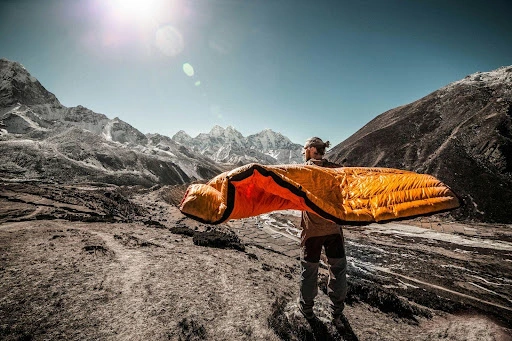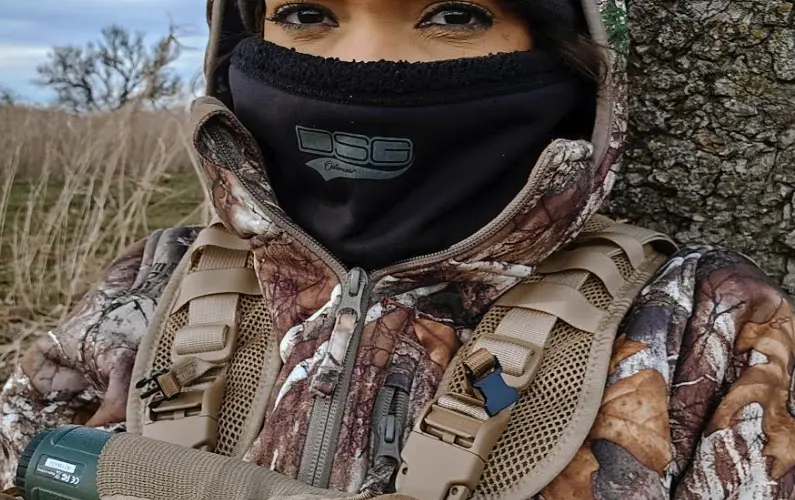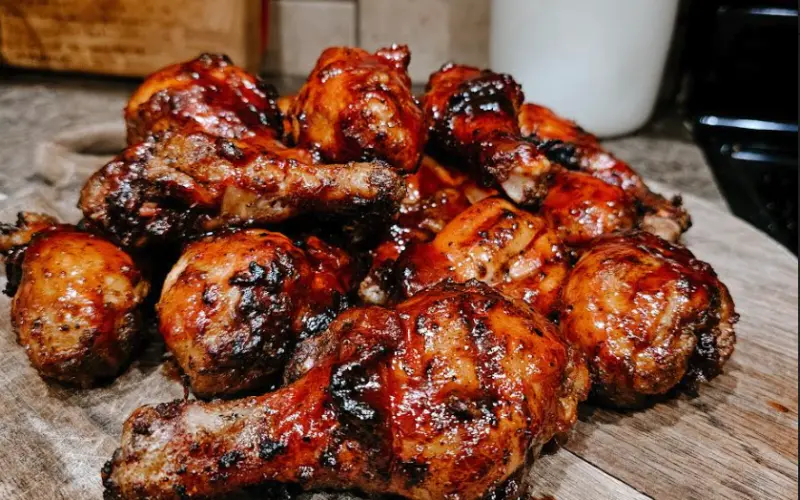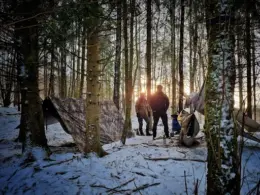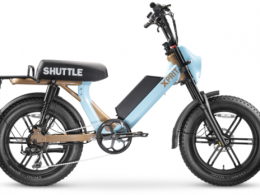Every seasoned camper will tell you—getting a good night’s sleep is one of the most important aspects of your outdoor adventure. There’s a big difference between waking up refreshed and waking up after what seems like a night of endless wakefulness. More often than not, this is because you got cold, which indicates that the sleeping bag wasn’t suitable for the temperature conditions.
A sleeping bag is more than just a sack to crawl into; it’s your portable bed, a sanctuary from the brisk night air, and your cozy hideaway from nature’s elements. The camping industry doesn’t make understanding sleeping bag ratings very easy, but this guide will demystify that for you.
Table of Contents
The Most Common Types of Sleeping Bags
When I first started camping, this threw me for a loop. I was used to there only being rectangular sleeping bags that I could turn into a blanket if needed. Little did I know that there are other variations to consider.
This is a good starting point because each type of sleeping bag has its pros and cons. There is more to the list than just these, but you’ll find these more commonly than the variations.
Mummy Sleeping Bags
I always found mummy bags to be restricting, so when I first learned about them, I stayed away. However, after camping in the winter, I quickly realized that the restrictiveness of the bag was all by design, and for good reason.
Mummy sleeping bags are designed to fit snugly around your body, minimizing empty space and thus maximizing warmth. Their tapered shape and hooded top make them ideal for cold-weather camping. If you value warmth and efficiency, the mummy bag is your go-to option.
One of my favorite things about a mummy bag now is how the hood can go right over your head, creating this warm cocoon. Waking up in the morning and feeling the cold outside, yet being in a warm mummy bag, is one of the best feelings a camper could have.
Rectangular Sleeping Bags
On the other end of the spectrum, rectangular sleeping bags offer much more room to stretch out. I enjoy these bags during the late spring/summer months as I don’t need as much heat retention. Many varieties also have this excellent, soft plaid material on the inside, which reminds me of a blanket at home.
You can generally unzip this style fully so that it turns into a top quilt of sorts. I’ll use these in a hammock as a top quilt that can fold down around me.
They’re less efficient at retaining heat but excel in comfort and versatility. Perfect for those who value a bit more wiggle room, especially in milder climates.
Barrel Sleeping Bags
Barrel sleeping bags strike a balance between the mummy and rectangular designs. They offer a bit more room than mummy bags but are still more form-fitting than rectangular ones. They’re great for campers who want a mix of warmth and comfort.
I don’t use this style as I have both of the other types, but if you’re someone who doesn’t want multiple sleeping bags, then this might be a good option that combines both.
Sleeping Bag Insulation Types
There are only two types of insulation that you’ll come across when searching for sleeping bags. While they both provide substantial warmth, there are some significant differences that you’ll need to consider.
Down Insulation
Down insulation is all about fluff and warmth. Made from the soft undercoating of birds, down insulation is exceptionally lightweight and compressible. If you want to save space in your pack, down is the best option.
There are two numbers you will have to remember when searching for a down sleeping bag:
- Fill Power: This number measures the loft or fluffiness of the down, indicating its insulating efficiency. Higher fill power means better insulation with less weight. For example, 600 fill power is good, while 800 or higher is considered excellent. It tells you how much space one ounce of down occupies in cubic inches. Higher fill power provides more warmth for less weight, making it ideal for lightweight and high-performance gear.
- Fill Weight: This number indicates the total amount of down used in the sleeping bag, usually measured in ounces or grams. It helps determine the overall warmth of the bag. A higher fill weight means more down is used, which generally results in a warmer sleeping bag. However, it also adds to the bag’s weight.
Unfortunately, some downsides can tend to turn people off.
Firstly, it can be pricey to purchase. This is mainly because the quality of this insulation is top-notch. It’s the best insulation (in my opinion) for keeping you warm in the winter, next to wool.
Another downside (and possibly the worst one) is that it loses its insulating properties when wet. Drying it out can also be a chore as if not done correctly, the insulation will clump and leave gaps in the heat retention capabilities.
If you can keep the down dry, this is the best insulation you can get to keep yourself warm and toasty on cold nights.
Synthetic Insulation
Synthetic insulation is made from man-made fibers designed to mimic the insulating qualities of down. While it is heavier and bulkier, it shines in wet conditions by retaining warmth, making it great for damp environments.
Different brands use various proprietary synthetic materials, such as PrimaLoft, Thinsulate, or proprietary blends. Each type has its characteristics in terms of warmth, weight, and compressibility.
It’s also quite affordable, fitting well within a budget while still offering reliable performance. Though it doesn’t compress as easily as down, its durability and moisture resistance provide peace of mind for campers facing unpredictable weather.
Similar to fill weight in down bags, synthetic bags may specify the weight of the insulation used, often in grams per square meter (g/m²). Higher numbers generally indicate more insulation and therefore more warmth, but also more weight.
For those prioritizing cost-effectiveness and reliability over weight and packability, synthetic insulation is a solid choice, catering to a wide range of camping adventures.
Temperature Ratings
This is the section that confuses people the most, and for good reason, manufacturers have never really been good at explaining the different ratings that come with sleeping bags. In a nutshell, these ratings indicate the lowest temperature at which the bag will keep an average sleeper warm.
Comfort Rating
The comfort rating of a sleeping bag refers to the lowest temperature at which an average cold sleeper can expect to stay warm and comfortable. It’s determined through standardized lab tests that simulate various sleeping conditions, ensuring a “reliable” guideline for consumers.
Those who tend to feel colder or prefer a cozy sleeping environment should pay special attention to the comfort rating when selecting a sleeping bag. This is the rating that will more than likely keep you warm during the night.
Limit Rating
The limit rating of a sleeping bag indicates the lowest temperature at which an average warm sleeper can maintain warmth throughout the night. This rating is also determined through standardized testing that assesses the bag’s insulation capabilities.
It’s particularly important for campers who are willing to layer up or naturally sleep warmer, providing a balance between warmth and weight. Choosing a sleeping bag based on its limit rating is vital for those hiking in cooler climates but wanting to minimize pack weight.
One trick I use is to treat this rating as the survival rating so that there is a much smaller chance of me experiencing a cold night’s sleep.
Extreme/Survival Rating
The extreme rating of a sleeping bag signifies the lowest temperature at which an average person can survive without frostbite, though not in comfort. I use this rating to understand the survival limits of a sleeping bag under severe weather conditions.
Campers planning trips in unpredictable or harsh climates should consider this rating to prepare for unexpected cold snaps. In my opinion, this rating should be far below what you’re expecting to encounter on your camping trip.
Conclusion
Choosing the right sleeping bag is about balancing your needs for comfort, warmth, and practicality. Whether you’re drawn to the snug efficiency of a mummy bag or the sprawling luxury of a rectangular one, remember that a good sleeping bag is an investment in countless cozy nights under the stars.

